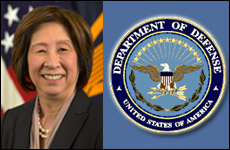
DISA’s next version of enterprise email goes far beyond email
DoD's forthcoming update to enterprise email is likely to include several other business collaboration tools, and will be rebranded as the "Defense Office...
When the Defense Information Systems Agency helped the Army migrate its thousands of globally scattered email servers into a centrally-managed enterprise offering five years ago, the effort was heralded as a success for cutting the Army’s costs by $80 million per year and boosting its cybersecurity.
But for the next version of enterprise email, the Defense Department’s chief information officer has told the agency to outsource the program to industry. And under those circumstances, DISA believes that email alone no longer makes sense. Under the agency’s latest plans, even the name will change: Defense Enterprise Email (DEE) will become the Defense Office Automation Service (DOAS).
Alfred Rivera, the director of DISA’s business and development center, said the project officials formerly referred to as DEE 2.0 will now likely be bundled with videoconferencing, chat and other collaboration tools.
The agency made the decision after first issuing a request for information to industry in which it solicited ideas on a commercially operated version of enterprise email without any other bells and whistles, aside from calendaring and email archiving functions that are required by federal recordkeeping laws.
“After that RFI, industry came back to us and told us that we’d see a much greater economic benefit by looking beyond just email and putting some other capabilities on top of that,” Rivera said in an interview with Federal News Radio. “So we’re revisiting the strategy to consider including a lot of those capabilities. That’s why it’s not going to be called Defense Enterprise Email anymore.”
Rivera said DISA is still developing the acquisition strategy for the newly-dubbed DOAS project and was not able to predict when the agency would release a final request for proposals.
It’s also unclear how the agency’s more ambitious tack toward its email offering will impact a longstanding project that aims to offer UC services to all of the military branches and Defense agencies.
Within DoD, the UC acronym stands for “unified capabilities”, but the concept is roughly synonymous with the “unified communications” buzzword that’s permeated the private sector for years to include phone calls, video, instant messaging and a host of other office communication tools in one seamless platform. In the military’s case, some classified and battlefield communications would be included under the UC umbrella.
“[DOAS] is not necessarily going to involve all unified capabilities, but we hope it’s going to encompass the essence of what our customers in the military services are looking for based on the feedback we’re getting from them,” Rivera said.
But for now, the Army — by far the largest customer of DISA’s existing enterprise email service — is pursuing its own path toward UC. Its program executive office for enterprise information systems plans to issue its own RFP by the end of fiscal 2016 for a software client-based approach that would deliver voice, video, instant messaging and presence as a managed service for the entire Army.
“We think our UC project has the potential to dramatically change the way the Army does business,” Doug Haskin, the project director for enterprise services told Federal News Radio in a Dec. 23 interview. “A lot of our users already have these capabilities on a local basis and they’re fine for internal use, but it hinders the ability to talk to people who are on a different server farm or using different technologies. We need to get to a soft client that can be deployed without a significant investment in end-user equipment.”
The present day DISA-operated enterprise email service started from the Army’s requirement to consolidate its own email systems — previously run by posts, camps and stations around the world — into a more cost-effective solution that would let its users move from one duty station to another without having to change their email addresses every time they deployed to a new location.
Five years later, Army soldiers, civilians and contractors comprise the vast majority of the users on the system, although the sprawling offices of the secretary of Defense and the Joint Staff have transitioned into the system too.
Previous DoD initiatives had ordered the other military services to migrate their email operations to the enterprise service. The Air Force has moved some of its accounts, including all of its headquarters staff, but the Navy and Marine Corps have successfully argued to Pentagon IT leaders that they’ve already been running their own enterprise network for a decade and have no need to migrate.
Haskin said the intersection between the DISA-provided email service and the Army’s own UC plans remains murky.
“There are a lot of questions,” he said. “If the commercial email offerings include the other messaging components, how and when do we integrate that into a single combined offering, or do we continue consuming a single, stovepiped email-only service from DISA? Do we do that in conjunction with our own UC services, or do they combine at some point? If they do, who’s got the lead on that, the Army or DISA? These are the questions we’re going to have to address over the next year.”
Copyright © 2025 Federal News Network. All rights reserved. This website is not intended for users located within the European Economic Area.
Jared Serbu is deputy editor of Federal News Network and reports on the Defense Department’s contracting, legislative, workforce and IT issues.
Follow @jserbuWFED





